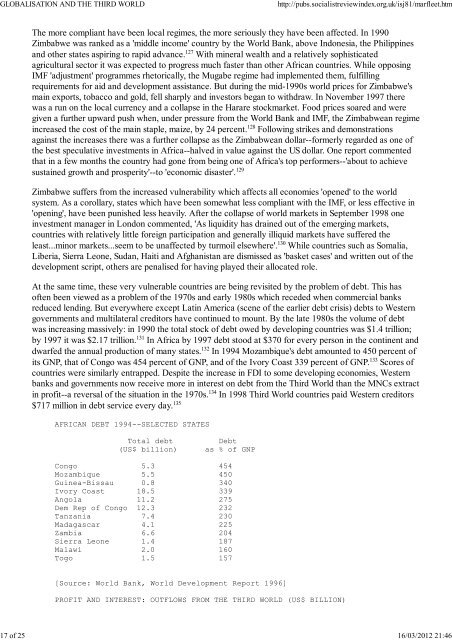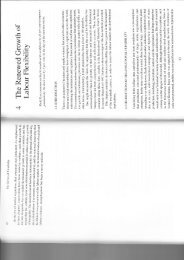<strong>GLOBALISATION</strong> <strong>AND</strong> <strong>THE</strong> <strong>THIRD</strong> <strong>WORLD</strong>http://pubs.socialistreviewindex.<strong>org</strong>.uk/isj81/marfleet.htm16 of 25 16/03/2012 21:46conditions reflecting largely the state of the advanced economies' and would be 'limited by the ways inwhich Western capitalists, still the dominant force in the system, respond to the fall in the world rate ofprofit'. 119In effect, capitalism has closed the NIC option for the forseeable future. Its ideologues nonethelessmaintain a double fiction: that industrialisation can be achieved and that the appropriate strategy is basedupon a specific model of the free market NIC. As recently as 1997, one leading US bank published lists ofTigers, Near-Tigers and Tiger Cubs, encouraging Third World governments to believe that they could jointhe developing elite. 120 Many ruling classes remain susceptible to the vision of progress within a'globalised' world, in which pursuit of free market policies on the Tiger model will bring developmentalrewards. In fact, from the 1940s, regimes in the East Asian NICs had followed a state capitalist path toindustrialisation and represent specific and probably unrepeatable cases of rapid capital accumulation inthe Third World. As Harris argued, 'Before the four existed, it had been necessary to invent them in orderto justify [neo-liberal theories]; and after they expanded, not a little invention went into rendering thefacts of their performance consistent with the postulates of the free market'. 121Especially misleading is the notion that in cases of the most rapid advance, notably Korea, the local statewithdrew from direct intervention in economic affairs. On the contrary, the state was (and remains)central: as one account of Korea notes, 'No state outside the Socialist bloc came anywhere near thismeasure of control over the state's investible resources'. 122 The fiction of Korean development hasnonetheless been incorporated into theories of globalisation to make an apparently seamless argument forfree market strategy. Institutions such as the World Bank and the IMF continue to embellish the mythwhile using control over funds to induce Third World governments to move away from protectionism,state ownership and market controls.Such 'liberalisation' was pioneered in the mid-1970s by the Sadat regime in Egypt through its infitah('opening') policy. The regime immediately enriched itself and its supporters through commission agencies,import-export scams, and speculation in property and finance. Within a few years a 'Sadat class' ofnouveaux riches had been accommodated by the ruling senior bureaucrats and army officers of the earliernationalist period. Hinnebusch describes the outcome:The new prosperity widened and solidified the regime's support among those who got the lion'sshare of the benefits, the bourgeoisie. Revitalisation of the private sector created powerfulinterests with a stake in the regime. Contractors, real estate speculators, and merchants flourishedon the economic boom; importers, partners and agents of foreign firms, tourist operators, lawyersand middle men who helped investors against bureaucratic tangles, thrived on the cuts they tookfrom resource inflow... On the other hand, the lower middle and lower classes bore the main costsof infitah while reaping the fewest benefits... The explosion of conscipuous consumption at the topfed a growing perception that class gaps were widening, the rich getting rich and the poorpoorer. 123Twenty five years after the initiation of infitah President Mubarak still talks of creating a 'Tiger on theNile' but sustained industrial growth on the NIC model remains a distant prospect. The story has beenrepeated in scores of states worldwide, as regimes with roots in an earlier era of state-led developmenthave embraced neo-liberalism and launched the inevitable attacks upon living standards, social welfareand upon workers' and peasants' rights.The African crisis: In many poor countries the aim of development policy has been less ambitious--simplyto halt economic decline. In 1991 the UN secretary general commented that Africa was heading for 'anunrelenting crisis of tragic proportions'. 124 But for African states the solution has been the same as foraspiring industrialisers--the implementation of 'adjustment' programmes which aim to create conditionscongenial to private capital accumulation. 125 The outcome has been to intensify crisis: in agriculturalproduction, industrial output, increased deforestation and desertification, rising food imports, decliningterms of trade and capital flight. Sandbrook comments, 'If it were not for the unenumerated andunregulated informal or parallel economy, life [for the masses] would be more even desperate'. 126
<strong>GLOBALISATION</strong> <strong>AND</strong> <strong>THE</strong> <strong>THIRD</strong> <strong>WORLD</strong>http://pubs.socialistreviewindex.<strong>org</strong>.uk/isj81/marfleet.htm17 of 25 16/03/2012 21:46The more compliant have been local regimes, the more seriously they have been affected. In 1990Zimbabwe was ranked as a 'middle income' country by the World Bank, above Indonesia, the Philippinesand other states aspiring to rapid advance. 127 With mineral wealth and a relatively sophisticatedagricultural sector it was expected to progress much faster than other African countries. While opposingIMF 'adjustment' programmes rhetorically, the Mugabe regime had implemented them, fulfillingrequirements for aid and development assistance. But during the mid-1990s world prices for Zimbabwe'smain exports, tobacco and gold, fell sharply and investors began to withdraw. In November 1997 therewas a run on the local currency and a collapse in the Harare stockmarket. Food prices soared and weregiven a further upward push when, under pressure from the World Bank and IMF, the Zimbabwean regimeincreased the cost of the main staple, maize, by 24 percent. 128 Following strikes and demonstrationsagainst the increases there was a further collapse as the Zimbabwean dollar--formerly regarded as one ofthe best speculative investments in Africa--halved in value against the US dollar. One report commentedthat in a few months the country had gone from being one of Africa's top performers--'about to achievesustained growth and prosperity'--to 'economic disaster'. 129Zimbabwe suffers from the increased vulnerability which affects all economies 'opened' to the worldsystem. As a corollary, states which have been somewhat less compliant with the IMF, or less effective in'opening', have been punished less heavily. After the collapse of world markets in September 1998 oneinvestment manager in London commented, 'As liquidity has drained out of the emerging markets,countries with relatively little foreign participation and generally illiquid markets have suffered theleast...minor markets...seem to be unaffected by turmoil elsewhere'. 130 While countries such as Somalia,Liberia, Sierra Leone, Sudan, Haiti and Afghanistan are dismissed as 'basket cases' and written out of thedevelopment script, others are penalised for having played their allocated role.At the same time, these very vulnerable countries are being revisited by the problem of debt. This hasoften been viewed as a problem of the 1970s and early 1980s which receded when commercial banksreduced lending. But everywhere except Latin America (scene of the earlier debt crisis) debts to Westerngovernments and multilateral creditors have continued to mount. By the late 1980s the volume of debtwas increasing massively: in 1990 the total stock of debt owed by developing countries was $1.4 trillion;by 1997 it was $2.17 trillion. 131 In Africa by 1997 debt stood at $370 for every person in the continent anddwarfed the annual production of many states. 132 In 1994 Mozambique's debt amounted to 450 percent ofits GNP, that of Congo was 454 percent of GNP, and of the Ivory Coast 339 percent of GNP. 133 Scores ofcountries were similarly entrapped. Despite the increase in FDI to some developing economies, Westernbanks and governments now receive more in interest on debt from the Third World than the MNCs extractin profit--a reversal of the situation in the 1970s. 134 In 1998 Third World countries paid Western creditors$717 million in debt service every day. 135AFRICAN DEBT 1994--SELECTED STATESTotal debt(US$ billion)Debtas % of GNPCongo 5.3 454Mozambique 5.5 450Guinea-Bissau 0.8 340Ivory Coast 18.5 339Angola 11.2 275Dem Rep of Congo 12.3 232Tanzania 7.4 230Madagascar 4.1 225Zambia 6.6 204Sierra Leone 1.4 187Malawi 2.0 160Togo 1.5 157[Source: World Bank, World Development Report 1996]PROFIT <strong>AND</strong> INTEREST: OUTFLOWS FROM <strong>THE</strong> <strong>THIRD</strong> <strong>WORLD</strong> (US$ BILLION)




